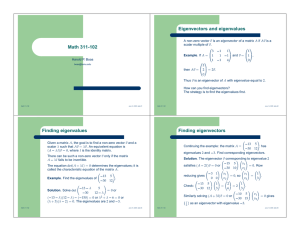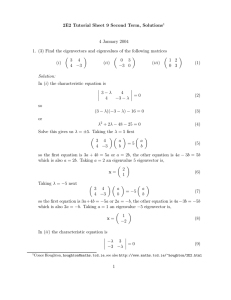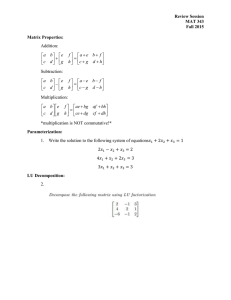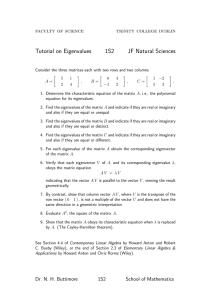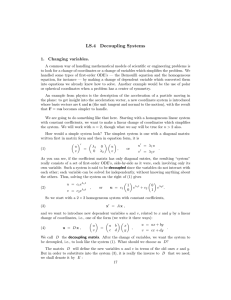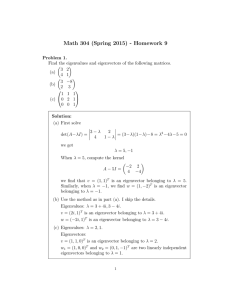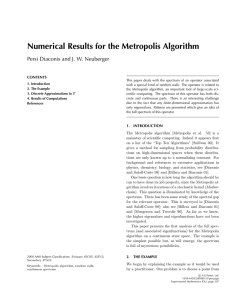EIGENVECTORS 1S2 TUTORIAL JF SCIENCES SCHOOL OF MATHEMATICS
advertisement
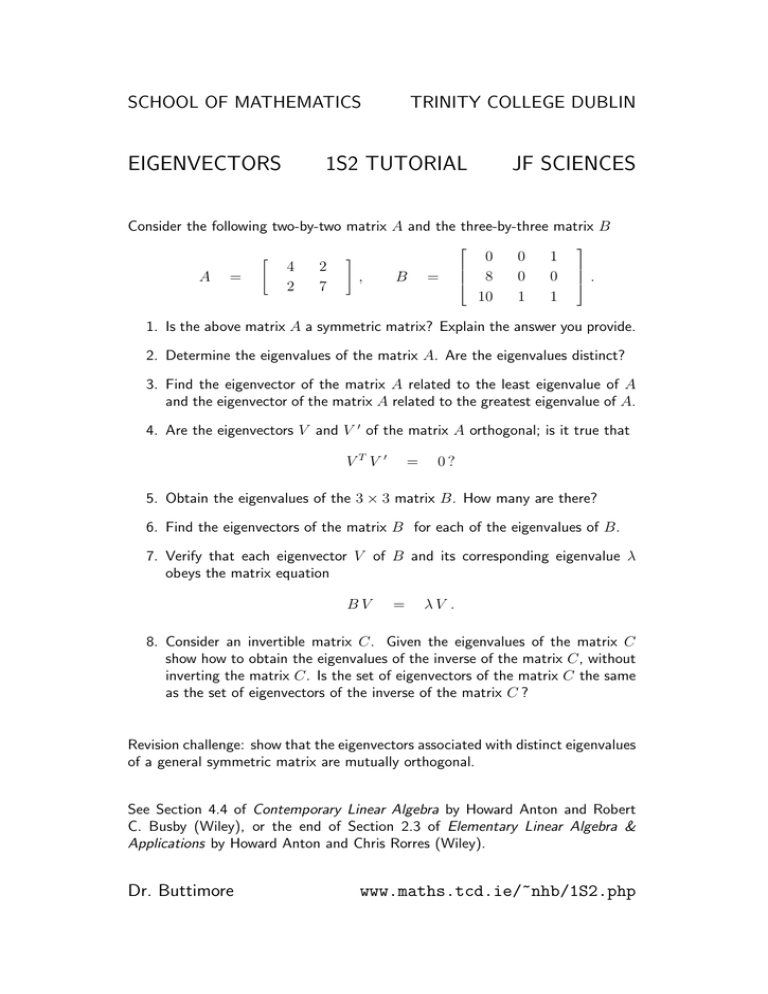
SCHOOL OF MATHEMATICS EIGENVECTORS TRINITY COLLEGE DUBLIN 1S2 TUTORIAL JF SCIENCES Consider the following two-by-two matrix A and the three-by-three matrix B A = " 4 2 2 7 # , B = 0 8 10 0 0 1 1 0 1 . 1. Is the above matrix A a symmetric matrix? Explain the answer you provide. 2. Determine the eigenvalues of the matrix A. Are the eigenvalues distinct? 3. Find the eigenvector of the matrix A related to the least eigenvalue of A and the eigenvector of the matrix A related to the greatest eigenvalue of A. 4. Are the eigenvectors V and V 0 of the matrix A orthogonal; is it true that VT V 0 = 0? 5. Obtain the eigenvalues of the 3 × 3 matrix B. How many are there? 6. Find the eigenvectors of the matrix B for each of the eigenvalues of B. 7. Verify that each eigenvector V of B and its corresponding eigenvalue λ obeys the matrix equation BV = λV . 8. Consider an invertible matrix C. Given the eigenvalues of the matrix C show how to obtain the eigenvalues of the inverse of the matrix C, without inverting the matrix C. Is the set of eigenvectors of the matrix C the same as the set of eigenvectors of the inverse of the matrix C ? Revision challenge: show that the eigenvectors associated with distinct eigenvalues of a general symmetric matrix are mutually orthogonal. See Section 4.4 of Contemporary Linear Algebra by Howard Anton and Robert C. Busby (Wiley), or the end of Section 2.3 of Elementary Linear Algebra & Applications by Howard Anton and Chris Rorres (Wiley). Dr. Buttimore www.maths.tcd.ie/~nhb/1S2.php A BACKGROUND ITEM FOR EIGENVECTORS OF A MATRIX An eigenvector example for substitution rates among the purine and pyrimidine bases of DNA generalises readily to other biomolecule rates. The bases of DNA with a double-ring structure, Adenine and Guanine, are called purines (denoted R). The bases with a single-ring structure, Thymine and Cytosine, are pyrimidines (Y). A large base and a small base pair together, A–T, G–C, in the DNA double helix. Averaged over some species, the proportion of purines (r%) and pyrimidines (y%) varies steadily as time proceeds over millions of years in such a way that, after a time period T , the values r and y, elements of a column vector X, change to MX " = 0.91 0.09 #" 0.11 0.89 # r y . Q. Given that the values of r and y are 35% and 65% respectively at the current time of t = 0, find a formula for values of r and y at a general time t = nT for integer n. Evaluate the proportions for time values n = −2, −1, 1, 2, (and ∞). Ans. Eigenvalues of the probability matrix M (columns sum to one) are given by det(M − λ I) = 0.91 − λ 0.11 0.09 0.89 − λ = λ2 − 1.8 λ + 0.8 = 0 leading to λ = 0.8 and λ0 = 1. For each eigenvalue the related eigenvector is obtained from the defining equation M V = λ V , that is, (M − λ I) V = 0 , or " #" 0.91 − λ 0.11 0.09 0.89 − λ u w # = 0. Writing out this matrix equation in component form provides the eigenvectors V and V 0 of the matrix M corresponding to the eigenvalues λ = 0.8 and λ0 = 1, V = " u w # = " # −1 1 0 , V = " u0 w0 # = " # 11 9 . Multiplying an eigenvector repeatedly by the matrix M yields for an integer n M V = λV , M 2 V = λ2 V , M n V = λn V , ··· , with similar equations for V 0 and λ0 . If the linear form with constants k and k 0 in M n (k V + k 0 V 0 ) k λn V + k 0 λ0 n V 0 = on the left can be matched to the values 35% and 65% at the time t = 0 by suitably choosing k and k 0 , then the right side provides the solution required. Writing out the matrix equation k V + k 0 V 0 = (35, 65) T in component form readily leads to k = 20 and k 0 = 5, indicating that the required solution is M n " 35 65 # n " 4 = 20 5 Dr. Buttimore −1 1 # +5 " 1S2 11 9 # ; " 23.75 76.25 # " , 30 70 # " ; 39 61 # " , 42.2 57.8 # School of Mathematics

